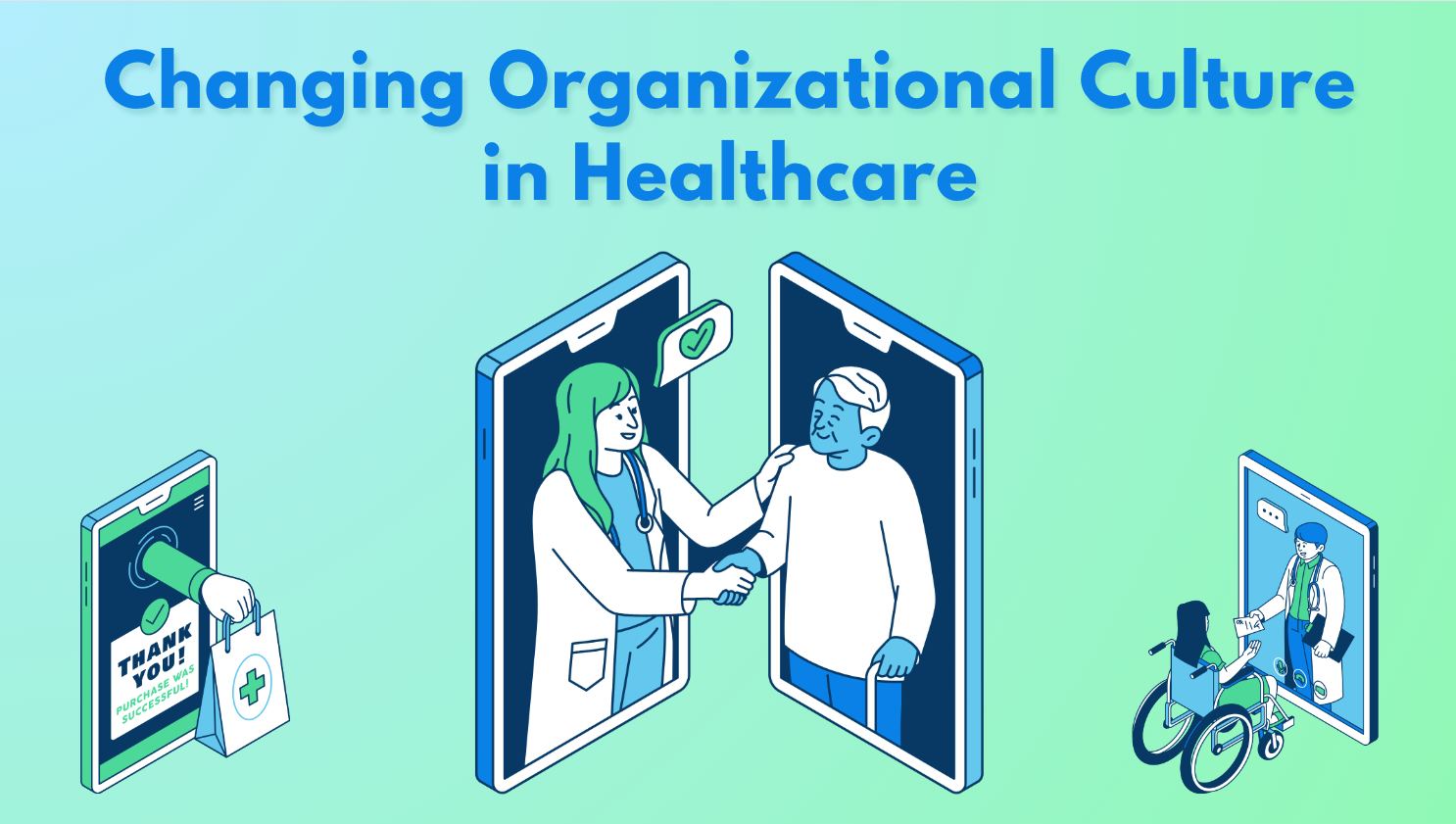How to Implement Culture Change in the Healthcare Workplace | Everything You Need to Know

Unlocking Positive Change: Your Guide to Transforming Healthcare Culture!
Are you ready to embark on a journey that promises not just change but a transformation in the heartbeat of healthcare organizations? Well, you’re in for a treat!
In our bustling world of scrubs, stethoscopes, and heartfelt care, the need for evolving and embracing new cultural norms in healthcare has never been more vital.
Imagine a healthcare environment where every patient feels seen, heard, and receives the same top-notch care, irrespective of their background. Picture a workplace where the buzz isn’t just about medical procedures but also about fostering a culture that nurtures innovation, collaboration, and, above all, compassion.
In this guide, we’re not just sharing information; we’re handing you the keys to unleash positive change! From understanding the intricacies of cultural competence to navigating the challenges unique to the healthcare landscape, we’ve got you covered.
So, whether you’re a passionate healthcare professional, an enthusiastic administrator, or someone eager to make a difference, this guide is your compass to navigate the seas of cultural change in healthcare. It’s not just about changing—it’s about evolving, adapting, and creating a healthcare haven that shines brighter for all.
Excited to discover what’s on the horizon? We’ve crafted a brief summary for you. Get ready to explore the top practices for transforming organizational culture in healthcare, and rest assured, we’re here to be your companions on this journey.
Quick Summary
Inclusive Care: Unveiling the Portrait of Cultural Competence in Healthcare
Cultural competence in healthcare refers to the ability of healthcare systems and facilities to adapt to and accommodate people from diverse backgrounds. It ensures that everyone, regardless of their socio-economic status, culture, language, or beliefs, receives equal and high-quality care. Achieving cultural competence may involve changes in the healthcare culture, such as implementing diversity training, overcoming language barriers, and recruiting a diverse staff.
Examples of cultural awareness in healthcare include having: interpreters, training staff on cultural awareness, treating every patient equally, coordinating with religious leaders, involving community leaders in staff training, expanding hours of operation, and emphasizing how cultural competence improves patient outcomes.
Revitalizing Care: Unpacking the Necessity for Healthcare Change
Healthcare needs to undergo cultural change to ensure cultural competence and provide equal care to all patients. Reports from organizations like the American College of Physicians, American Bar Association, and Agency for Healthcare Research and Quality highlight the existing disparities:
- Minorities face less access to healthcare compared to non-minorities.
- Low-income individuals experience worse access to care than those with higher incomes.
- A study of 400 hospitals revealed that black patients with heart disease received older and cheaper treatments than their white counterparts.
- Minority women were less likely to receive radiation therapy after a mastectomy compared to non-minority women.
These findings emphasize the imperative to change corporate culture and enhance cultural awareness in healthcare, aiming to provide uniform, high-quality care to every patient.

Shifting Tides: Understanding the Complexity of Cultural Change in Healthcare Organizations
Implementing culture change in healthcare organizations is challenging due to the need for significant procedural changes to enhance cultural competence and awareness. This requires a systematic change management strategy to ensure the alterations are methodical and sustainable. The healthcare industry is particularly resistant to change due to its entrenched culture.
Several factors contribute to the difficulty of implementing culture change in healthcare:
- Organizational DNA: Healthcare organizations may perceive their existing practices as their “DNA,” leading to resistance with sentiments like “We’ve always done it this way” or “We know what we’re doing; we don’t need to change.”
- Resistance from Various Groups: Different groups within healthcare, such as physicians, nurses, lab technicians, administrators, and billing/front office staff, resist change due to ingrained practices, busy schedules, or fear of the unknown.
- Distinct Institutional Cultures: Each group within healthcare has its own institutional culture, adding complexity to the change process. Some cultures are more open to change, while others, particularly those emphasizing rigid structures and regulations, may resist ongoing quality improvement.
Changing behaviors and beliefs within diverse healthcare groups contribute to the difficulty of altering the corporate culture in health and social care. The challenge lies in addressing resistance, fostering collaboration, and navigating varied institutional cultures to successfully implement and sustain culture change.
From Vision to Reality: Strategies for Hospital Culture Evolution
Changing the culture of hospitals to overcome cultural barriers in healthcare is achievable with patience, commitment, and effective communication. Key strategies for changing organizational culture in healthcare include:
- Create a Vision with Milestones: Develop a vision that addresses existing problems and outlines the positive outcomes the change will bring, especially in terms of cultural competence. Implementing cultural competence in healthcare should be staged with milestones.
- Communicate & Address Change Resistance: Effective communication throughout the culture change process is crucial. Address resistance to change by communicating goals, objectives, and progress regularly. Anticipate and be prepared to address individual resistance positively.
- Enlist Leaders and Change Agents: Seek support from leaders and change agents to drive change in different departments. Leaders and change champions can identify cultural barriers in healthcare and provide crucial assistance in fostering understanding and acceptance.
- Use a Change Model: Implement a change model to guide the planning, implementation, and sustainability of culture change in healthcare. This model serves as a methodology and offers best practices for managing change.
- Celebrate Milestone Wins: Break down the change process into phases and celebrate milestones along the way. Recognizing achievements regularly boosts morale, sustains excitement, and garners continued support for the cultural change project.
Throughout these strategies, emphasizing the WIIFM (what’s in it for me) factor helps individuals understand the personal benefits of the change. Positive communication about cultural awareness in healthcare is essential to ensure everyone feels included and motivated in the journey toward cultural competence.

Guiding the Shift: Strategies for Effective Change Management in Healthcare Organizations
Managing change in a healthcare organization is more likely to succeed when guided by a change model or methodology. Several change models can help transition culture in healthcare organizations effectively:
- Prosci ADKAR Model:
- A: Awareness of the change
- D: Desire to change
- K: Knowledge of how to change
- A: Ability to demonstrate new skills and behaviors
- R: Reinforcement to make the change stick
- Three-stage process: Preparing for change, Managing change, Reinforcing change
- Kurt Lewin Change Model:
- Unfreeze: Preparing people to let go of old behaviors
- Change: Teaching the new way to do things
- Freeze: Reinforcing changes
- Includes Force Field Analysis to address resistance and support for change
- John Kotter 8-Step Change Model:
- Create a sense of urgency
- Build a guiding coalition
- Form a strategic vision and initiatives
- Enlist a volunteer army
- Enable action by removing barriers
- Generate short-term wins
- Sustain acceleration
- Institute change
- Emphasizes maintaining urgency and momentum throughout the change
- McKinsey 7S Framework:
- Shared Values
- Skills
- Staff
- Strategy
- Structure
- Style
- Systems
- Designed to ensure harmony among these seven organizational areas during culture change
Organizations may adopt a single change model for all cultural changes or may use different models based on specific situations. Regardless of the choice, these methodologies provide a framework for managing projects that involve changing corporate culture in healthcare.
Detailed Deep Dive
When discussing culture in healthcare, there are two different areas that need to be addressed to help instill cultural competence in healthcare.
The first is addressing the changes that need to be made to improve the ability of a healthcare organization to offer care to patients of diverse backgrounds, values, belief systems, languages, and nationalities (i.e., create cultural competence in healthcare).

Cultural Awareness in Healthcare
The second type of culture is the organizational culture.
The organizational culture in the healthcare industry can hold a facility and their staff back from making the changes needed for cultural competence in healthcare, as well as any other change.
For any type of change in processes, you need to undo habits, behaviors, and ways of doing things in order to teach new behaviors to institute change. Implementing culture change in healthcare theory and practice can be very challenging because it’s human nature to be resistant to change.
Culture and healthcare go hand in hand. For example, most healthcare organizations will have a culture of safety in everything they do. Another part of the culture in health and social care may have to do with an organization’s history.
Compare a hospital in the middle of a big city to one in a small rural town. Both would have different cultures and, thus, different cultural barriers in healthcare change management.
In this article, we’re first going to address cultural competence in healthcare, what that means and what types of changes may be needed for implementing culture change in healthcare to make an organization more culturally competent.
Then, we’ll discuss how to go about changing the corporate culture in a healthcare facility to create an environment were that needed change can happen.
See Also: Applying Best Change Management in Healthcare | All You Need to Know
Do you have questions on how to improve workplace culture in healthcare? or about the various culture improvement in healthcare? We’d love to hear from you, click here to contact us.
What is Cultural Competence in Healthcare?
The ability of healthcare systems, processes, and the adopted culture in healthcare facilities to accommodate different types of people from a diverse range of backgrounds is called cultural competence in healthcare.
As a basic example: If a family came into the emergency room and could only describe what a child’s symptoms were in Spanish, a facility that has cultural competence in healthcare would have a way to translate that critical information accurately.
No matter where you live or work, there is a diversity of different socio-economic backgrounds, cultures, languages, religions, and belief systems. Unfortunately, people of certain backgrounds haven’t always had the same level of care as others.
Some may be predisposed to different chronic diseases or have the ability to afford preventative health more than others. The goal of cultural competence in healthcare is that everyone receives the same level of care, no matter their background, culture, sexual orientation, belief system, etc.
Don’t Miss: Best Healthcare Consulting Firms
Got questions like “What is culture change in healthcare?” or “What is cultural transformation in healthcare?” Drop us a message and let us know.
What Does Cultural Competence in Healthcare Look Like?
Depending upon the current culture of a particular hospital or healthcare facility, culture change in healthcare may be needed to bring it to cultural competence.
Change may include putting diversity training into place as well as systems that can overcome language barriers. Cultural change in the healthcare workplace isn’t always easy, but it’s essential for ensuring that no matter a patient’s background, they receive the best possible level of care.
What does that look like?
Here are some examples of what cultural awareness in healthcare would include:
- Recruiting a diverse staff of different ethnic backgrounds
- Having interpreters available
- Training staff on cultural awareness and knowledge
- Enforcing behaviors that treat every patient the same no matter the socio-economic background
- Coordinating with religious healers/leaders
- Addressing culture and healthcare and how the two intersect
- Including community leaders in staff training about culture in healthcare
- Expanding hours of operation
- Teaching understanding of how cultural competence in healthcare improves patient outcomes
- Adding diversity to healthcare pamphlets and advertising
Related: Adapting to Change in the Workplace | All You Need to Know
Are you looking answers to questions like “What are the types of organizational culture in healthcare?” or “How to implement culture change in healthcare organizations?” Send us a message with your questions or comments.
Why Does Healthcare Need to Change?
Cultural change in the healthcare workplace is needed to ensure facilities are culturally competent and giving all patients the same level of care.
Reports by organizations like the American College of Physicians, American Bar Association, and Agency for Healthcare Research and Quality all show that there’s a long way to go when it comes to cultural competence in healthcare.
Some of the findings show that:
- Minorities have less access to healthcare than non-minorities
- Low-income people have worse access to care than high income
- A study of 400 hospitals showed that black patients with heart disease received older and cheaper treatments than white counterparts
- Minority women were less likely to receive radiation therapy with a mastectomy than non-minority
Those are just a few examples illustrating the need for changing corporate culture and increasing cultural awareness in healthcare, so every patient receives the same high quality of care.
Why is Culture Change So Difficult in Healthcare Organizations?
Now that we’ve discussed the importance of cultural competence in healthcare, let’s talk about how culture change in healthcare takes place.
In order to implement the types of changes needed to increase cultural competence and cultural awareness in healthcare systems, new procedures and ways of doing things need to be put into place.
Anytime you’re changing the way an individual or organization does something, it requires a change management strategy to ensure the change is done methodically and in a way that will ensure the change is sustained.
In any organization, a change will hit barriers and resistance, but the culture in health and social care makes the healthcare industry particularly prone to change resistance.
Why is this?
Implementing culture change in healthcare is difficult because you’re changing what some organizations see as their “DNA.” You’ll run into resistance such as, “We’ve always done it this way,” or “We know what we’re doing, we don’t need to change.”
When implementing culture change in healthcare theory and practice, you’re going up against several different distinct groups, such as:
- Physicians who are used to calling the shots, not being told what to do
- Nurses who often are too busy to even think about a new change
- Lab technicians with certain ways of doing things
- Administrators that may not be fully on board with a change
- Billing and front office staff who may be afraid of what change will mean
Each of these individual groups will not only be ingrained in the organizational culture in the healthcare industry as a whole, but they’ll also have their institutional culture and the culture of their individual group.
Some of these existing cultures are more open to change than others, and not all are created equally.
For example, in the article “Implementing culture change in healthcare: theory and practice,” the authors note that culture in healthcare that emphasizes groups, teamwork, and coordination tends to be associated with continuous improvement practices.
But the culture in healthcare that is more rigid and emphasizes structures and regulations may be negatively associated with ongoing quality improvement activities.
Thus, the first group would most likely be more open to culture change in the healthcare workplace than the second.
Changing behaviors and ingrained beliefs in a variety of different groups are the main reasons changing the corporate culture in health and social care can be difficult.
Popular Article: Best Ways for Leading a Team Through Change in the Workplace
Are you looking for more information on how to improve workplace culture in healthcare or want a better understanding of healthcare organizational culture then send a message to our change management team.
How Do Hospitals Change Culture?
Overcoming cultural barriers in healthcare and changing the culture of hospitals can be done successfully. It just requires patience, commitment, and lots of communication.
Those driving change to organizational culture in healthcare have to understand that change happens with the people. For the hospital to change, the people working in it need to change first.
For culture and healthcare to be changed, people have to understand the benefits of that change, not only to the organization and the patients but also to them individually. We call this the WIIFM (what’s in it for me).
Having an answer to WIIFM helps overcome resistance and remove cultural barriers in healthcare change.
Here are some of the ways to change organizational culture in the healthcare industry to facilitate a change to cultural competence in healthcare.
Create a Vision with Milestones
Your vision for change should address the problem that exists and the solution the change will bring. In the case of cultural competence, the change would mean that all patients, no matter their differences, would receive identical levels of high-quality care, improving patient outcomes.
A change as significant as improving the cultural competence in the healthcare of a hospital would need to be done in stages, which is why you would want to include milestones.
Creating a vision helps you promote culture change in the healthcare workplace in a way that multiple groups will understand (nurses, physicians, etc.).
Communicate & Address Change Resistance
When people aren’t communicated with about a change, confusion can set in and people tend to assume the worst about a project. Make sure you’re communicating throughout the culture change in healthcare about goals, objectives, and how the project is progressing.
Be ready to address resistance as you are changing corporate culture and processes; this is natural. If you anticipate and are prepared to address individual resistance to change, you’ll find that culture and healthcare systems can be moved in a positive direction.
Part of your communication will be about cultural awareness in healthcare, what that means, and how everyone can move towards cultural competence. Be sure you keep things positive, so none feels they’re being shamed because of any lack of cultural awareness in healthcare systems.

Culture Change in Healthcare
Enlist Leaders and Change Agents to Help
One of the best methods of implementing culture change in healthcare is to enlist help. Leaders and change agents (also known as change champions) can help drive change in various departments and identify any cultural barriers in healthcare groups that you may not be aware of.
Coaching leaders helps them understand how they can support organizational change in healthcare when it comes to employees working under their leadership. Not everyone has experience with managing change, which is why leadership coaching is a good idea.
Your change agents are employees that are well respected in their group or department. They can help others understand the change and report back any concerns that people may have about the change in organizational culture in healthcare organizations.
Use a Change Model to Manage Change
When you’re going through a culture change in healthcare, a change model will give you a methodology to use that can help you with planning your change activities.
It can also help you understand how to orchestrate a change in organizational culture in healthcare industry facilities. And provide you with a basic background of the best practices for planning, implementing, and sustaining change.
We’ll discuss more about change models for change in culture in health and social care in the next section.
Celebrate Milestone Wins
Projects for implementing culture change in healthcare can take years, with different phases being passed through along the way. If you wait too long to cheer on your team and celebrate wins, people can get tired of the project and become complacent.
When you are implementing culture change in health care theory and practice, including milestones along the way that everyone can celebrate will go a long way towards sustaining excitement and support for the change project.
Want to find out out more information on organizational culture healthcare and how to improve workplace culture in healthcare? Send a message to our change management team.
How Do You Manage Change in a Healthcare Organization?
Culture change in the healthcare workplace has a better chance of success when you use a change model/methodology to guide your strategic planning and implementation.
A change model can give you a general overview of how culture change in the healthcare workplace should happen and lay out a set of instructions to follow for change management that drives a project to completion.
The following are a few examples of change models and how they can help you transition culture in healthcare organizations.
The Prosci ADKAR Model
The ADKAR model from Prosci uses an acronym to explain the stages that people must be guided through for successful change in culture and healthcare.
These are:
- A: Awareness of the change
- D: Desire to change
- K: Knowledge of how to change
- A: Ability to demonstrate new skills and behaviors
- R: Reinforcement to make the change stick
This model also gives you a three-stage process that will guide your project for changing corporate culture:
- Phase 1: Preparing for change
- Phase 2: Managing change
- Phase 3: Reinforcing change
The Kurt Lewin Change Model
Lewin’s model of change is based on the psychology of what people go through when changing corporate culture. It describes a three-stage process:
- Unfreeze: When you’re preparing people to let go of old behaviors
- Change: When you’re teaching the new way to do things
- Freeze: When you reinforce those changes
This model to help manage culture change in the healthcare workplace also includes Lewin’s Force Field Analysis, which is about addressing resistance to change (restraining forces) and fostering support for the change (driving forces).
The John Kotter 8-Step Change Model
Kotter’s 8-step change model emphasizes keeping urgency and momentum going throughout the change to the culture in healthcare. It provides eight different activities to guide your culture and healthcare facility change initiative.
- Create a sense of urgency
- Build a guiding coalition
- Form a strategic vision and initiatives
- Enlist a volunteer army
- Enable action by removing barriers
- Generate short-term wins
- Sustain acceleration
- Institute change
McKinsey 7S Framework
The McKinsey 7S Framework is designed to help you understand seven important parts of your healthcare organization and the need to keep them all in harmony during the culture change in the healthcare workplace.
These seven organizational areas are:
- Shared Values
- Skills
- Staff
- Strategy
- Structure
- Style
- Systems
Some organizations will adopt one change model that they’ll use for every change in culture and healthcare processes, and others will try more than one, adjusting the model to fit each different situation.
Whichever you use, these methodologies will give you a framework for managing projects changing corporate culture.
Conclusion: The Best Practices for Culture Change in the Healthcare Workplace
One of the most significant changes that could be made in a hospital or healthcare facility is to adopt cultural competence in healthcare. As our population gets more diverse, it’s vital that healthcare facilities provide everyone an equal level of high-quality care.
Cultural awareness in healthcare will reduce the disparity in patient care based upon factors like race, income, belief system, sexual orientation, and other differences, helping to ensure that care is standard across the board for everyone.
Driving a culture change in the healthcare workplace isn’t always easy because you have to change ingrained organizational culture in healthcare that’s been there for many years. However, using the right techniques, it can be done successfully.
Following change management best practices for changing culture in healthcare facilities can ensure that even large change initiatives can be handled strategically, with consideration for resistance factors, and in a way that everyone comes out a winner.
Read More: Implementing Change Management in the Workplace
Note: Content on OCM Solution's ocmsolution.com website is protected by copyright. Should you have any questions or comments regarding this OCM Solution page, please reach out to Ogbe Airiodion (Change Management Lead) or the OCM Solutions Team today. OCM Solution was previously known as Airiodion Global Services (AGS).
Images: https://stock.adobe.com, Microsoft 365 Clip Art Image(s) (Bing images licensed under the Creative Commons license system.)





